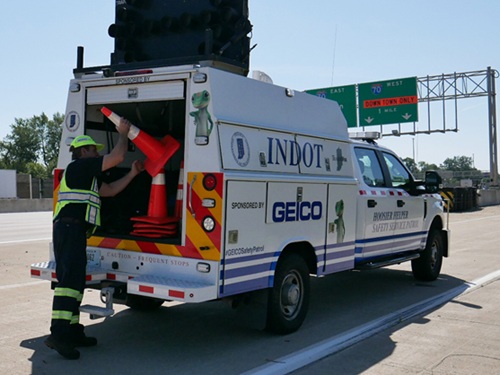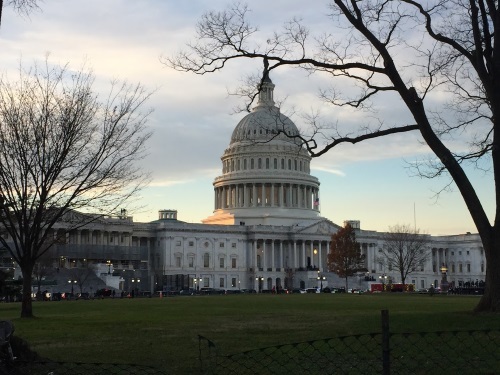An Arizona law that made it illegal to hold a cellphone while driving has indeed reduced handheld conversations via those devices, but did not reduce other manual cellphone activities, according to a new study from the Insurance Institute for Highway Safety (IIHS).
[Above photo via Pxhere]
Arizona passed such a law in April 2019, allowing police to issue written warnings immediately and to begin issuing citations in January 2021. Prior to 2019, Arizona had no statewide cellphone ban for drivers of all ages, though some local communities banned handheld calls, texting or both.

To measure the law’s impact, IIHS researchers analyzed roadside observation data from trained observers and telematics data from insurers’ safe-driving apps from before and after the law went into effect – comparing trends from Arizona with Nevada, which does not have a law against holding a cellphone but has banned texting and handheld calls since 2012.
The roadside observers recorded the percentage of drivers they saw holding a phone, manipulating a phone or holding a phone to their ear, as well as the apparent age and sex of the driver. Stationed at specific locations, they could only note drivers using their phones at the moment they passed the observation spot.
Telematics data compiled anonymously from insurance companies’ safe-driving apps showed that Arizona drivers spent 26 percent less time on handheld calls after the ban went into effect. Yet the data also showed the new law had little impact on cellphone “manipulation” – an umbrella term that encompasses scrolling, swiping, typing and any other action that requires holding the device.
Roadside observations showed that, relative to Nevada drivers, Arizona drivers were about 7 percent less likely to be seen having handheld conversations immediately after the law went into effect than before, though the result was not statistically significant.
The telematics data showed larger reductions. The first year that the law was in effect, drivers were about 17 percent less likely to make handheld calls and 22 percent less likely to be on a handheld call at any given moment. By 2024, those reductions widened to 21 percent and 26 percent, respectively.
The picture was different for cellphone manipulation. Roadside observations showed a small decline, but it was not statistically significant. Telematics data showed slight increases in the likelihood of cellphone manipulation occurring on trips. At any given moment of a trip, cellphone manipulation declined slightly during the first year the law was in effect, then increased slightly through 2024.

Pre-existing local ordinances may have influenced results, IIHS noted, as roadside observation data showed reductions in handheld calls in Mesa-Scottsdale and Phoenix, which did not have prior handheld calling bans. Tucson, which already had handheld calling and texting bans before the state law, did not see reductions.
“The fact that drivers continued to type and scroll in the wake of a law that made it illegal even to hold the device shows how hard it’s going to be to stop this behavior,” said Ian Reagan, senior research scientist at IIHS and lead author of the study, in a statement. “Sustained, high-visibility enforcement efforts are likely needed to make drivers take the new law seriously.”
“These results are a bit of a reality check,” added David Harkey, IIHS president. “‘No holding’ laws are a positive step, but it will take more than better-worded legislation alone to combat cellphone distraction.”
While IIHS noted that there are no reliable estimates of the number of crashes caused by distracted drivers, the organization stressed that “the evidence is strong” that looking away from the road to focus on something other than driving increases crash risk. Additionally, the more demanding the secondary task and the longer the driver’s eyes are away from the road, the greater the crash risk becomes, IIHS said.
While that’s true of any secondary activity, cellphones are the most common culprit, the organization added – pointing to a national two-year study of 3,100 drivers that found that they used their cellphones more than six times as often as they reached for other objects.
Early bans targeted narrow behaviors like handheld conversations or texting, but jurisdictions are increasingly adopting comprehensive bans on holding an electronic device while driving. An earlier IIHS study showed that such stronger laws were associated with rear-end crash reductions in Oregon and Washington, though not in California.
That being said, several states highlighted over the past year notable roadway safety benefits from the passage of “hands free” laws.
In June 2023, Michigan became the 26th state in the U.S. to adopt hands-free device legislation; a law that penalizes motorists found to be using cell phones without the use of hands-free technology. And a survey conducted by Michigan State University (MSU) indicates that “hands free” law is having a positive effect.
“We saw a 1.2 percentage point decrease in the number of drivers using handheld devices compared to the same time period a year ago,” noted Tim Gates, a professor of civil and environmental engineering in the MSU College of Engineering, in a blog post. “When you consider that Michigan has approximately 8 million licensed drivers, this translates to approximately 96,000 fewer drivers using handheld devices.”
And in October 2024, Ohio Governor Mike DeWine (R) noted at a news conference that traffic crashes statewide “significantly decreased” in the year since enforcement of Ohio’s strengthened distracted driving law began.
According to preliminary Ohio State Highway Patrol or OSHP data at the time, there were approximately 1,112 fewer distracted driving crashes in Ohio from October 5, 2023, to October 4, 2024, compared to the 12 months prior. Fatal crashes attributed to distracted driving also dropped 19.4 percent, the agency noted.
The impact of the new law is also reflected in the overall decrease in crashes in Ohio, supporting the theory that drivers don’t always admit to driving distracted before a collision.
Preliminary data from OSHP shows that from October 5, 2023, to October 4, 2024, there were nearly 15,400 fewer motor vehicle crashes compared to the 12 months prior. The total number of traffic fatalities also dropped with 138 fewer people killed. “This is exactly what we expected would happen,” said Gov. DeWine in a statement at the time. “Ohio’s tougher distracted driving law is influencing better behavior behind the wheel, leading to fewer crashes and fewer deaths.”
 Nation
Nation
Confusion Reduces ‘Slow Down, Move Over’ Law Impact
November 14, 2025 Nation
Nation

